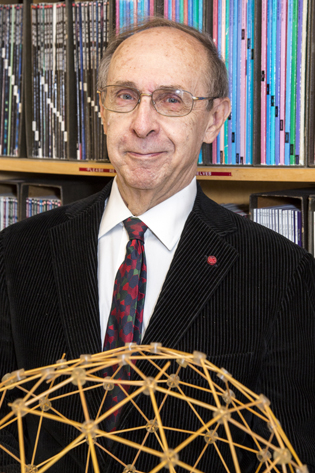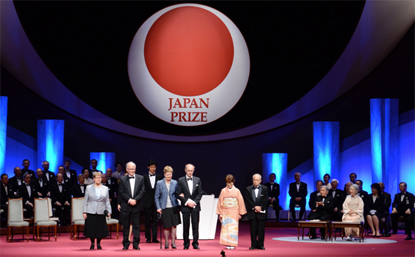Alumni News
Looking Past the Glitz
Theodore Friedmann: The Father of Gene Therapy
NIH alum Theodore Friedmann may be too modest to brag about his pioneering role in gene-therapy research, but the Japan Prize Foundation sure wasn’t when it bestowed its prestigious prize on him and two other scientists earlier this year. The annual Japan Prize recognizes “significant contributions to the progress of science and technology as well as society to serve the cause of peace and prosperity of mankind.” Since its inception in 1985, 83 laureates from 13 countries have received the Japan Prize and several have gone on to win the Nobel.

PHOTO BY RYAN PARKS, UCSD
NIH alum Ted Friedmann was recently awarded the Japan Prize for his contributions to the development of gene therapy and its clinical applications.
Friedman and French scientist Alain Fischer (Institut Imagine, Paris) were celebrated for the “proposal of the concept of gene therapy and its clinical applications.” The third scientist, Yutaka Takahasi (professor emeritus at the University of Tokyo), was recognized for his contribution to the “concept of river-basin management and reduction of water-related disasters.”
The Japan Prize Foundation “looked past the glitz and noise and went back in the history,” said Friedman, who began his work on gene therapy at NIH in the 1960s and is now a professor of pediatrics and director of the Gene Therapy Program at the University of California at San Diego (UCSD, in La Jolla).
As the gene-therapy field was evolving in the 1970s and 1980s, “there was a lot of hype and controversy,” said Alan Schechter, a senior investigator in the National Institute of Diabetes and Digestive and Kidney Diseases. He shared a lab with Friedmann at NIH and is still a close friend. “Ted has been active in the field—he convened meetings, wrote and edited books and continued to focus on ethical issues,” said Schechter. But “he never held press conferences [and] never hyped.”
It was Friedmann who in 1972 co-authored an influential Science paper that is considered important in the scientific beginnings of gene-therapy research (Science 175:949–955, 1972). The article described the concept of gene therapy, proposed a way forward in research, and cautioned about the dangers and ethical issues surrounding gene therapy, too.
Friedmann, who graduated with a degree in chemistry (1956) and an M.D. (1960) from the University of Pennsylvania (Philadelphia), came of age in the era of molecular biology. He was inspired by the likes of Francis Crick and James Watson, who had, in 1953, co-discovered (with Rosalind Franklin) the structure of DNA, a feat that won them the Nobel Prize in Physiology or Medicine in 1962; his medical school professor Colin MacLeod, who contributed to the demonstration that DNA encodes properties of genes; and British biochemist Frederick Sanger, who received the first of his two Nobel Prizes in Chemistry in 1958 for his work on the structure of proteins, especially that of insulin. (The second was in 1980 for his “contributions concerning the determination of base sequences in nucleic acids.”)
“I wanted to learn more from the people pushing the frontiers of molecular medicine,” Friedmann said in his Japan Prize lecture. So in 1963, he went to work with Sanger for a year at the University of Cambridge (Cambridge, U.K.). He met his future wife, Ingrid Stromberg, in Cambridge, too.
He returned to the United States to complete a residency in pediatrics at Harvard’s Boston Children’s Hospital. Still eager to learn more about protein chemistry, he made his way to the National Institute of Arthritis and Metabolic Diseases (NIAMD), where he and Schechter worked with Christian Anfinsen and Charles Epstein on protein chemistry and protein folding. (Anfinsen went on to share the Nobel Prize in Chemistry in 1972 for his work on the enzyme ribonuclease and the way in which it folds to its biologically active form.)
Friedmann was anxious to apply what he’d learned to human genetics. After two years in Anfinsen’s laboratory, he moved to NIAMD’s Laboratory of Human Biochemical Genetics, where J. Edwin Seegmiller and Scottish researcher John Subak-Sharp were investigating uric acid and Lesch-Nyhan syndrome. Seegmiller had just discovered that a defect in the HPRT1 gene causes the rare, hereditary syndrome that affects young boys and is characterized by neurological abnormalities, compulsive self-injurious biting behavior, involuntary muscle movements, and the overproduction of uric acid.
It was in Seegmiller’s lab that Friedmann made his first foray into gene therapy. “We wanted to see if we could fix the genetic defect in the children,” Friedmann said. He and Subak-Sharp cultured some of the abnormal skin cells from a patient and exposed them to normal DNA. A small number—about one in a million—showed evidence that the genetic defect had been corrected. “It was the first time that was done,” said Friedmann. But “the process was inefficient.” Friedmann wanted to find a way to genetically correct many more mutated cells, but he knew it wouldn’t be easy. (Nature 220:272-274, 1968)
“It was the first time that was done,” said Friedmann. But “the process was inefficient.” He wanted to find a way genetically correct many more mutated cells, but he knew it wouldn’t be easy. (Nature 220:272–274, 1968)
In 1968, Friedmann left NIH for a visiting scientist position at the Salk Institute in La Jolla, California and a faculty post at UCSD. At Salk, he worked with another soon-to-be Nobel laureate—Renato Dulbecco. Dulbecco had discovered that tumor viruses infected normal cells by carrying their DNA into them. “If we could teach the virus to carry normal genes—not tumor genes—we might be able to correct genetic abnormalities,” Friedmann recalled thinking.
Dulbecco went on to share the Nobel Prize in Physiology or Medicine in 1975 for his discoveries concerning the interaction between tumor viruses and the genetic material of the cell. At this point, Friedmann was anxious to learn more about DNA itself and returned to Sanger’s lab in 1976 to do that; they published several papers together dealing with methods for determining DNA-sequences.
Then Friedmann returned to UCSD to continue working on gene-delivery mechanisms and techniques to trick the virus into being a vector for therapeutic genes, especially for Lesch-Nyhan syndrome.
Meanwhile, scientists at NIH and elsewhere were starting to develop gene-therapy techniques. There was a lot of excitement, but “Ted’s contribution tended to get lost,” said Schechter.
In 1995, then–NIH Director Harold Varmus commissioned a report that identified many concerns with the gene-therapy field. “Varmus at the time didn’t like what he saw, and he criticized the field sharply,” said Friedmann. “The NIH director and others lost faith in us [and] chastised us.”
Nevertheless, the news media eagerly promoted gene therapy until 1999, when 18-year-old Jesse Gelsinger, who was being treated for a genetic liver disease, died during a gene-therapy clinical trial at the University of Pennsylvania. His was the first death caused by gene therapy.

At the Japan Prize celebration, the winners had the honor of meeting the Emperor and Empress of Japan (seated at small table on right). The Japan Prize winners and their wives are pictured in foreground, from left: Alain Fischer, Ted Friedman, and Yuktaka Takahasi.
“We began to question the concept of gene therapy,” Friedmann said. “Are we just fooling ourselves?” he wondered at the time.
But in Europe in the late 1990s, fellow Japan Prize winner Alain Fischer, director of immunology at the Necker Hospital (Paris), was beginning to use gene therapy techniques to treat children who suffered from X-linked severe combined immunodeficiency disease (SCID), in which the lack of an immune system renders a child subject to serious infections.
“Gene therapy wasn’t a real field until the clinicians got busy,” said Friedman. “Without Fischer [and his success in treating this disease], the concept would have wallowed around.”
Unfortunately, five of the 20 children in Fischer’s trials developed leukemia (one died) due to a component in the modified virus that was used to carry the corrective gene.
Since then, the technology has improved: Safer and more efficient gene-delivery viruses—such as the lentiviruses—have been found. More children with SCID have been successfully treated. Other diseases are now being approached with these methods, too.
Another success happened in 2008, said Friedmann: Jean Bennett of the Perelman School of Medicine at the University of Pennsylvania,led the first team to use gene therapy to treat patients with the previously untreatable blinding disease Leber’s congenital amaurosis (LCA).
Some of the patients “could see!” said Friedman. Although completely normal vision was not achieved in that study, the results have provided the basis for further gene-therapy studies in patients with LCA. (N Engl J Med 358:2240–2248, 2008)
In addition, clinical trials have suggested that gene therapy may be effective in treating several childhood degenerative brain diseases, hemophilia, and other disorders. And new gene-therapy technologies—such as gene editing to correct mutant genetic sequences—are showing promise for the future.
Finally in the last decade, “I knew the [clinical] field was emerging,” said Friedman, who is trying to establish a gene-therapy center at UCSD. “It was very gratifying.”
And Friedmann found it gratifying to have had mentors who were the “greatest scientists of the last century”—Sanger, Anfinsen, Seegmiller, Dulbecco, and others. They were gentle, were interested in truth and science, and let their work speak for itself, according to Friedmann. “It takes a very special person to be that good,” he said. “To emulate [them] is a challenge.”
Friedmann certainly seems to have met that challenge.
Theodore Friedmann, M.D.
Professor, Department of Pediatrics
University of California, San Diego
Education: University of Pennsylvania, Philadelphia (A.B. in chemistry, 1956; M.D., 1960); University of Oxford, Oxford, England (M.A. in biology, medicine, and chemistry, 1995)
Training: Residency in pediatrics, Children’s Hospital Medical Center, Boston (1960–1962); senior resident (1964–1965); teaching fellow, Harvard University, Cambridge, Mass.; research fellow in colloid science, University of Cambridge, Cambridge, U.K., laboratory of Frederick Sanger (1963–1964; 1976–1977); postdoctoral training, Salk Institute for Biological Sciences, La Jolla, Calif., with Renato Dulbecco (1968–1969)
Military: Captain, U.S. Air Force, 10th Tactical Hospital, Alconbury, England (1963–1964)
NIH: Laboratory of Chemical Biology, NIAMD, with Charles Epstein and Christian Anfinsen (1965–1967); Laboratory of Human Biochemical Genetics, NIAMD, with J. Edwin Seegmiller (1967–1968)
Current positions: University of California, San Diego (1969–present): professor of pediatrics; Muriel Jeanette Whitehill Chair in Biomedical Ethics; director, Gene Therapy Program; adjunct professor, Department of Molecular and Experimental Medicine, The Scripps Research Institute, La Jolla, Calif.
Outside interests: Spending time with his family; playing piano
This page was last updated on Monday, April 25, 2022
